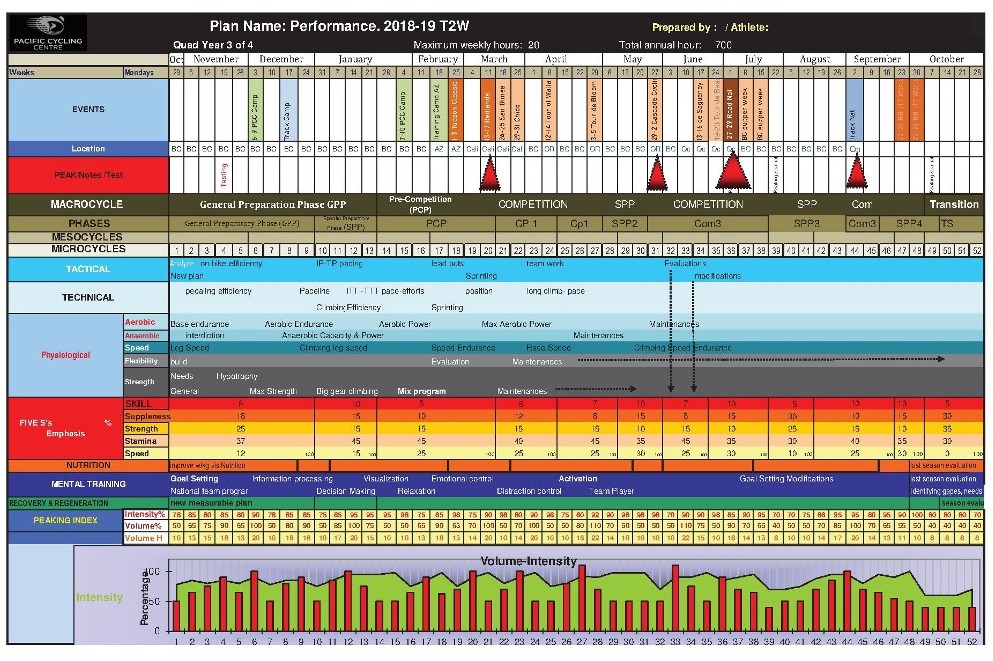Fundamentals of a Yearly Training Plan

The main idea behind developing a Yearly Training Plan (YTP) is to create a systematic approach to training, competition, and rest/recovery. Crafting a YTP is a highly developed coaching art form drawing on coaching experience, athlete history, and the most current research and science. The “art” of a YTP comes from the fact that it needs to be as simple as possible while still addressing all of the complexities of training. A YTP is a living document that needs to be monitored/maintained and modified. A “complete” plan gives the coach and athlete the ability to plan better for the future, and manage, record and measure all of the various aspects of their training.
A YTP divides the athlete’s season into periods with “peaks” at certain key points in the year. Periodization of YTP can be divided into single, double, triple or multiple periods depending on athlete/team needs, their competition schedule, and level of experience.
Aim of Yearly Training Plan YTP
- Development
- Performance
A YTP should have the following component and elements:
Periods:
- Preparation; covers all component of Training
- Competition; covers all aspects of Competition
- Transition; Covers all element of rest
Phases:
- General Preparatory Phase (GPP)
- Specific Preparatory Phase (SPP)
- Pre-competitive Phase (PCP)
- Competitive Phase (CP)
- Transition Phase (TP)
Mesocycles:
- Developmental
- Stabilising
- Pre-Competition
- Competition
- Restorative (adaptation / regeneration)
Microcycles:
- Introductory
- Developmental
- Shock / load
- Stabilising
- Competitive
- Taper
- Peak
- Modelling
- Restorative (adaptation / regeneration)
- Transitional or active rest
Here is how it works:
- A YTP cycle is one part of a quadrennial plan
- A YTP is made up of periods and phases
- Periods are made up of mesocycles
- Mesocycles are made up of microcycles
- And microcycles are made up of Units
Each period or phase will have a different goal or function. Fundamentally, they are dependent on how far or how close the cycle is from competition. Periods farther away from competition focus on higher volume and lower intensity. The closer the period is to competition the lower the volume and higher the intensity,
For the Units of a Microcycle, I usually use durations of seven days. The length and type of microcycles depend on an athlete/team needs. The cycle is personalized differently for neural or metabolic adaptations. Before I start to develop a YTP for a athlete I need to know basic and very important information about the athletes such as: his/her chronological vs. biological age, training age (general-specific, how many years) and utilize those figures to identify an athlete’s stage in Long Term Athlete Development (LTAD) model.
Stages of LTAD
- Fundamentals
- Learning to Train (L2T)
- Training to Train (T2T)
- Training to Compete (T2C)
- Training to Win (T2W)
Once the stage of LTAD has been identified and I know what stage the athlete is in, I collect the information I need to develop the YTP. The most important element is balancing competition with school/work schedules. It is essential to know the dates of all races on the athlete’s calendar and to categorize them in terms of importance. I start with the most important race of the year and develop the plan backwards. This includes determining the total volume for the YTP and maximum volume per microcycle, (volume for cycling is measured by time and distances.) The second element is to determine how the YTP will be maintained, modified, and evaluated. Deciding how the athlete will report back to me and what sort of data they will provide is fundamental to this process
Based on those findings, I then choose the aim of YTP (development or performance,) fit the periodization element (single, double, triple or multiple,) build the duration of each period (Preparation, Competition, and Transition,) establish and fit the duration of each phases (GPP-SPP-PCP-CP-TP,) figure the duration and type of mesocycles (Developmental, Stabilising, Pre-Competition, Competition, Restorative – adaptation / regeneration) and finally structure the microcycles, and the units within each microcycle. It is an intricate process with a lot of puzzle pieces to fit together.
The length of each YTP is usually about 52 weeks depending on the year with each month and week organized and built around the athlete’s race program.
Included in the program is a constant monitoring system for medical, physiological, psychological, nutritional and recovery/regeneration needs. The monitoring system is based on the particular athlete’s needs and can include monitoring, testing and programs for the following elements:
Physiological Elements and Factors:
Aerobic
- Low End Aerobic
- Endurance Aerobic
- Maximal Aerobic Power
Anaerobic
- Anaerobic Alactic Capacity
- Anaerobic Lactic Power
- Anaerobic Lactic Capacity
Flexibility
- Dynamic
- Static
- PNF
Speed
- Acceleration Speed (Speed Strength)
- Speed Endurance
- Maximum Speed
Strength
- Respiratory System
- Core Strength / Endurance
- Relative Strength
- Strength Endurance
- Maximum Strength
- Elastic Strength (Power)
Nutrition
- Plans
- Management
Psychology
- Goal Setting
- Information Processing
- Decision Making
- Visualization
- Distraction Control
- Emotional Control
- Relaxation
- Activation
- Team Player
Recovery/ Regeneration
- Sleep management
- Recovery monitoring
- Recovery Management
- Weight Management
- Travel Management
Volume / Intensity
- Unite percentage
Reference, Istvan Balyi, NCI
